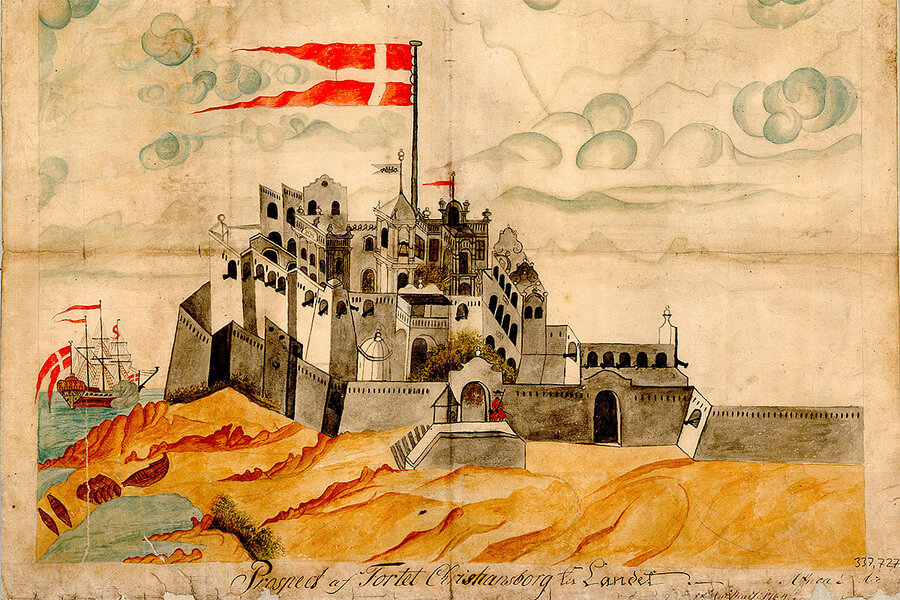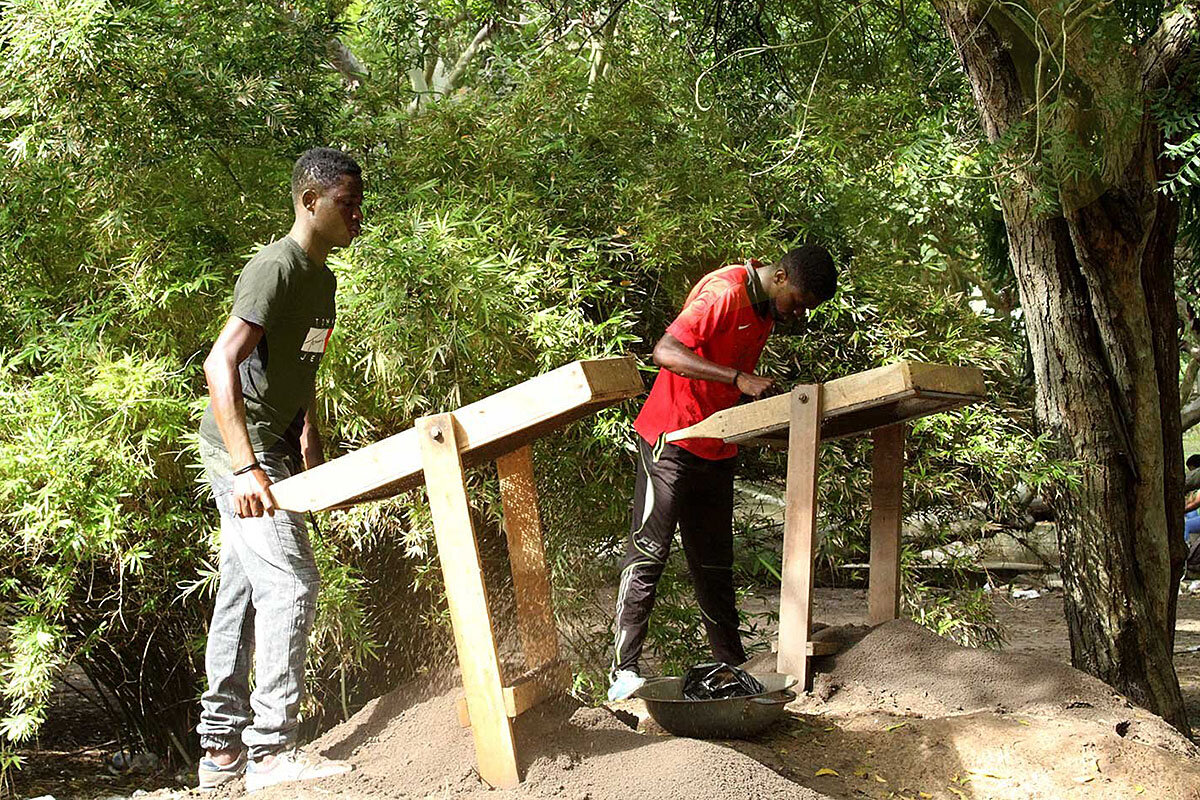Slave trade revisited: For Ghanaian archaeology team, past is personal
Loading...
For the past few summers, Ghanaian English archaeologist Rachel Ama Asaa Engmann has found herself unearthing a difficult history – quite literally.
Christiansborg Castle, a three-story former slaving fort with bright white walls, juts out into the Atlantic Ocean on the coast of Ghana. This is the site Dr. Engmann has been excavating. And this is the site, she has learned, where her own great-great-great-great-great-grandfather was once the Danish governor, overseeing the sale of thousands of human beings bound for the Danish West Indies.
Why We Wrote This
African communities often played complicated roles in the transatlantic slave trade. In Ghana, one Ghanaian English archeologist and her local team are uncovering that uncomfortable history.
“It’s something that takes a long time to process,” she says. “Even now, I’m still processing it.”
Like many slavers, he started a family in Ghana, who went on to work in the slave trade. Each summer, she gathers a team of local Ghanaians, many of whom have Danish last names like hers, and together they sift through the ground where their ancestors worked and lived.
It’s timely work, particularly as the world commemorates the 400th anniversary of the arrival of the first slaves in what is now the United States. It has also been difficult, because it means reckoning with the complicated roles that Africans played – and not only as slavery’s victims. But who better to uncover the history of Christiansborg, Dr. Engmann reasons, than the people that history belongs to?
Growing up, when people asked Ghanaian-English archaeologist Rachel Ama Asaa Engmann why she had a Danish last name, she had an easy answer.
It came from her great-great-great-great-great-grandfather, a Danish missionary who had settled on Ghana’s coast in the 1700s and started a family there.
It was an easy answer, yes. But, she’s since learned, it was also untrue.
Why We Wrote This
African communities often played complicated roles in the transatlantic slave trade. In Ghana, one Ghanaian English archeologist and her local team are uncovering that uncomfortable history.
Well, not completely. There had been a Danish man in Ghana named Carl Gustav Engmann, and Rachel was his direct descendant. But that was where the similarities between the family lore and the truth began and ended.
Because Carl Gustav Engmann wasn’t a missionary. He was the governor of a slaving fort, his job to oversee the sale of thousands of human beings bound for the Danish West Indies. And like many slavers, he started a family in Ghana, who went on to work in the slave trade themselves.
So that – not a mission to spread the gospel, not the adventuring of a pious Dane – was how there came to be a line of Ghanaian Engmanns.
Over the past several years, Dr. Engmann, now an assistant professor of African studies at Hampshire College in Massachusetts, has dedicated herself to unearthing that difficult history – quite literally. Each summer, she gathers a team of Ghanaians, many of whom have last names like hers – the Lutterodts and the Richters, the Reindorfs and the Svanikers – and together they sift through the ground beneath Christiansborg Castle, the former slaving fort in the Ghanaian capital in which their ancestors lived and worked.
It’s timely work, particularly as the world commemorates the 400th anniversary of the arrival of the first slaves in British North America, and the long shadow it cast over the modern world. [Editor’s note: This article has been modified to reflect the correct significance of the year 1619 in the history of the transatlantic slave trade.] But the project has also, at times, been profoundly difficult, because it has meant reckoning with the complicated roles that Africans played. In Ghana, like much of West Africa, they were not just slavery’s victims but also in some cases among its proponents, participants who made possible the trade of people bound for labor half a world away.
“We’re not at a point in Ghana yet where we’re talking openly about our heritage as slavers,” Dr. Engmann says. “But if we want to tell complicated and nuanced histories, if we want to give Africans agency in how we talk about slavery, we have to acknowledge that they had the agency to be collaborators as well as resisters.”
Dr. Engmann’s journey to this project began more than a decade ago, when an aunt told her casually that Carl Engmann’s name was inscribed on a water cistern at Christiansborg Castle, a three-story former slave fort that juts out into the Atlantic Ocean in the Osu neighborhood of Accra, the Ghanaian capital.
It was an odd place for a missionary’s name to be, and so Dr. Engmann began to look for answers. She pored over family trees sketched out by a grand-uncle, and then records in the Danish National Archives.
By the time she finished, her family’s history had been warped into an almost unrecognizable shape. They were no longer the descendants of a missionary, but of a slave trader.
“It’s something that takes a long time to process,” she says. “Even now, I’m still processing it.”
The weight of that discovery, indeed, followed Dr. Engmann as she finished her doctorate and began her career as an archaeologist in the United States. There, she found spirited discussions happening among her fellow archaeologists about the profession’s past – which was strongly linked to the exploration of “exotic” societies during the colonial period – and its potential future as a more inclusive discipline.
Wanting to play a role in that transformation, she decided to return to Ghana, where she asked the Ghanaian government for permission to excavate on the castle grounds.
And then she went looking for a team.
But instead of shipping in a gaggle of eager American archaeology students to sift through the earth, Dr. Engmann decided to recruit more locally. So locally, in fact, that she barely had to leave the castle grounds.
Just on the other side of the fort’s bright white walls lived a community largely descended, like Dr. Engmann, from Danish slave traders and their local Ga wives. Who better to uncover the history of Christiansborg, she reasoned, than the people whom that history belonged to?
One of those descendants was Malik Ludvig Lutterodt, who in 2015 was casting around for a job to help pay his tuition as a business student at a local university. A friend mentioned that the Christiansborg project was recruiting community members, and Mr. Lutterodt thought, “Sure, fine, I need a way to pay my fees, so why not?”
But quickly, his interest deepened.
Jumbled in the ground beneath him, he realized, were many histories, because the castle had lived many lives. As the team worked, they found beads, clay pipes, and shards of Chinese pottery from the era of the slave trade. But there were also the foundations of a pre-colonial kitchen, along with worn coins, medals, and other relics of the building’s later uses – first as the seat of the British colonial government, and later as an office and official residence of the president of Ghana.
Each year the team returns, he says, they uncover more and more buried in the ground here.
“My whole life, this castle was beside my house but I never really knew its history,” he says. “And if not for this project, it would still be that way. Our history would still be underground.”









